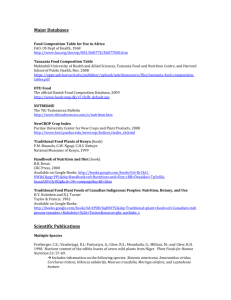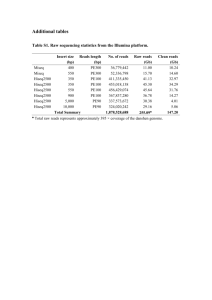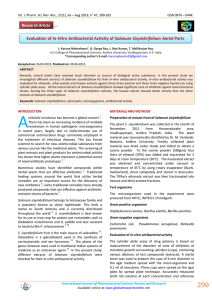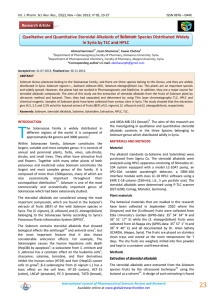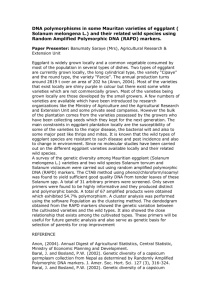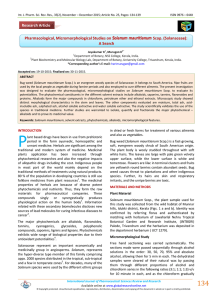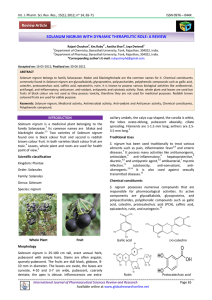British Journal of Pharmacology and Toxicology 3(4): 185-189, 2012 ISSN: 2044-2467
advertisement
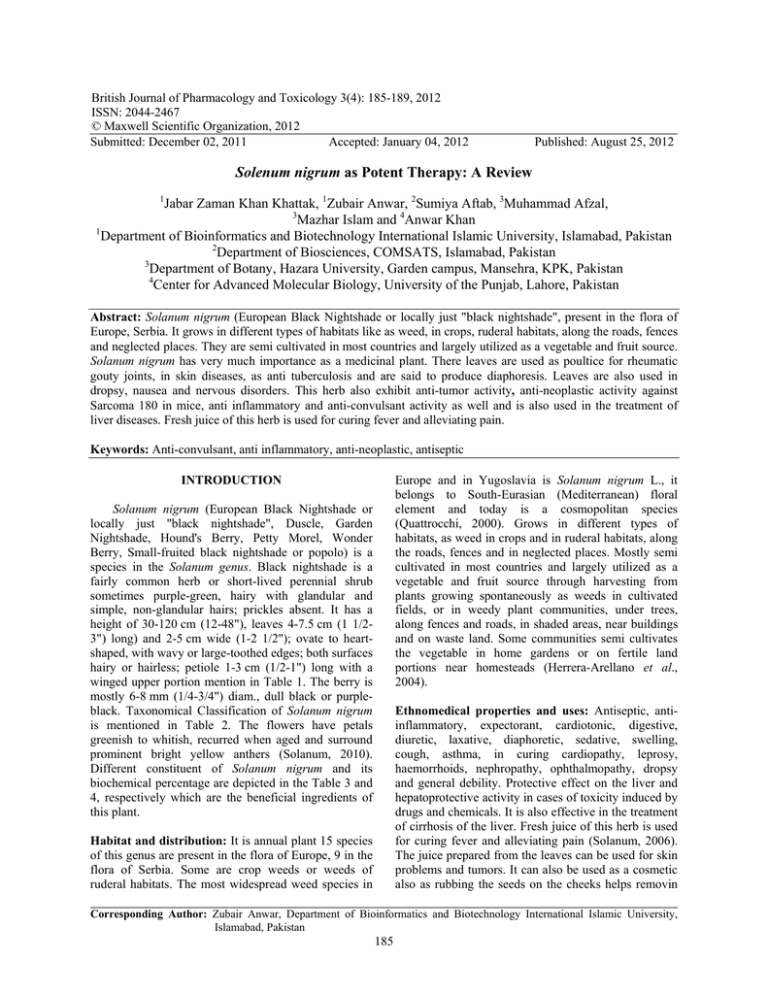
British Journal of Pharmacology and Toxicology 3(4): 185-189, 2012 ISSN: 2044-2467 © Maxwell Scientific Organization, 2012 Submitted: December 02, 2011 Accepted: January 04, 2012 Published: August 25, 2012 Solenum nigrum as Potent Therapy: A Review 1 Jabar Zaman Khan Khattak, 1Zubair Anwar, 2Sumiya Aftab, 3Muhammad Afzal, 3 Mazhar Islam and 4Anwar Khan 1 Department of Bioinformatics and Biotechnology International Islamic University, Islamabad, Pakistan 2 Department of Biosciences, COMSATS, Islamabad, Pakistan 3 Department of Botany, Hazara University, Garden campus, Mansehra, KPK, Pakistan 4 Center for Advanced Molecular Biology, University of the Punjab, Lahore, Pakistan Abstract: Solanum nigrum (European Black Nightshade or locally just "black nightshade", present in the flora of Europe, Serbia. It grows in different types of habitats like as weed, in crops, ruderal habitats, along the roads, fences and neglected places. They are semi cultivated in most countries and largely utilized as a vegetable and fruit source. Solanum nigrum has very much importance as a medicinal plant. There leaves are used as poultice for rheumatic gouty joints, in skin diseases, as anti tuberculosis and are said to produce diaphoresis. Leaves are also used in dropsy, nausea and nervous disorders. This herb also exhibit anti-tumor activity, anti-neoplastic activity against Sarcoma 180 in mice, anti inflammatory and anti-convulsant activity as well and is also used in the treatment of liver diseases. Fresh juice of this herb is used for curing fever and alleviating pain. Keywords: Anti-convulsant, anti inflammatory, anti-neoplastic, antiseptic Europe and in Yugoslavia is Solanum nigrum L., it belongs to South-Eurasian (Mediterranean) floral element and today is a cosmopolitan species (Quattrocchi, 2000). Grows in different types of habitats, as weed in crops and in ruderal habitats, along the roads, fences and in neglected places. Mostly semi cultivated in most countries and largely utilized as a vegetable and fruit source through harvesting from plants growing spontaneously as weeds in cultivated fields, or in weedy plant communities, under trees, along fences and roads, in shaded areas, near buildings and on waste land. Some communities semi cultivates the vegetable in home gardens or on fertile land portions near homesteads (Herrera-Arellano et al., 2004). INTRODUCTION Solanum nigrum (European Black Nightshade or locally just "black nightshade", Duscle, Garden Nightshade, Hound's Berry, Petty Morel, Wonder Berry, Small-fruited black nightshade or popolo) is a species in the Solanum genus. Black nightshade is a fairly common herb or short-lived perennial shrub sometimes purple-green, hairy with glandular and simple, non-glandular hairs; prickles absent. It has a height of 30-120 cm (12-48"), leaves 4-7.5 cm (1 1/23") long) and 2-5 cm wide (1-2 1/2"); ovate to heartshaped, with wavy or large-toothed edges; both surfaces hairy or hairless; petiole 1-3 cm (1/2-1") long with a winged upper portion mention in Table 1. The berry is mostly 6-8 mm (1/4-3/4") diam., dull black or purpleblack. Taxonomical Classification of Solanum nigrum is mentioned in Table 2. The flowers have petals greenish to whitish, recurred when aged and surround prominent bright yellow anthers (Solanum, 2010). Different constituent of Solanum nigrum and its biochemical percentage are depicted in the Table 3 and 4, respectively which are the beneficial ingredients of this plant. Ethnomedical properties and uses: Antiseptic, antiinflammatory, expectorant, cardiotonic, digestive, diuretic, laxative, diaphoretic, sedative, swelling, cough, asthma, in curing cardiopathy, leprosy, haemorrhoids, nephropathy, ophthalmopathy, dropsy and general debility. Protective effect on the liver and hepatoprotective activity in cases of toxicity induced by drugs and chemicals. It is also effective in the treatment of cirrhosis of the liver. Fresh juice of this herb is used for curing fever and alleviating pain (Solanum, 2006). The juice prepared from the leaves can be used for skin problems and tumors. It can also be used as a cosmetic also as rubbing the seeds on the cheeks helps removin Habitat and distribution: It is annual plant 15 species of this genus are present in the flora of Europe, 9 in the flora of Serbia. Some are crop weeds or weeds of ruderal habitats. The most widespread weed species in Corresponding Author: Zubair Anwar, Department of Bioinformatics and Biotechnology International Islamic University, Islamabad, Pakistan 185 Br. J. Pharmacol. Toxicol., 3(4): 185-189, 2012 Table 1: Measurements of plant Inflorescences Peduncle 4-12 flowered 10-20 mm long Table 2: Taxonomical classification Kingdom Sub division Plantae Angiosperms Class Eudicots Pedicels 10 mm long Order Asterids Table 3: Names of constiutunents of Solenum nigrum Alkaloid Steroid alkaloid Steroidal saponins Glycoprotein Flavonoids Tannins Table 4: New glycoprotein (150 KDa) Contents Carbohydrate Protein content (%) (%) (%) Age 69.74 30.26 Carbohydrates Phytosterols Coumarins Proteins Glycosides Glycine and proline (%) 50 freckles. Decoction of stalk, leaves, roots are good for wounds and cancerous sores. An infusion of the plant is used as an enema in infants having abdominal upsets. Freshly prepared extract of the plant is effective in the treatment of cirrhosis of the liver and also serves as an antidote to opium poisoning. The leaves are used as poultice for rheumatic and gouty joints, skin diseases, used in the treatment of anti tuberculosis and are said to produce Diaphoresis. Leaves are also used in dropsy, nausea and nervous disorders. The juice of the berries used as an antidiarrhoea, opthalmopathy and hydrophobia. It is also used in anasarca and heart disease. Berries are used to posses tonic, diuretic and cathartic properties. Seeds are useful in giddiness and dipsia. The roots are useful in otopathy, ophthalmopathy, rhinopathy and hepatitis. It has been reported earlier that aerial parts of Solanum nigrum is believed to offer its antiulcer action through acid and peptic suppression in aspirin induced ulcerogenesis in rats (Solanum, 2010). Phytoconstituents from Solenum nigrum: Solanum nigrum contains the substances, such as total alkaloid, steroid alkaloid, steroidal saponins and glycoprotein, exhibiting anti-tumor activity. It contains alkaloids, flavonoids, tannins, saponins, glycosides, proteins, carbohydrates, coumarins and phytosterols. Hussain et al. (1992). It was also seen the chemical characterization of osmotin-like protein from this plant. Small unripe fruits of Solanum nigrum had a high concentration of solasodine, but both the concentration and the absolute amount per fruit decreases with fruit maturation (Kirtikar and Basu, 1935; Nadkarni, 1976). The berries of Solanum nigrum from New Zealand have Calyx 1.5-2.2 mm long Sub order Solanales Lobes 1 mm long Family Solanaceae Genra Lanum Corolla stellate 8-12 mm diam Species S. nigrum recently been studied and found to contain 4 steroidal alkaloid glycosides, Solamargine, Solasonine, α and bsolanigrine. The berries of Solanum nigrum have been found to contain a saturated steroidal genin, which has been identified as tigogenin by mixed melting point and IR spectroscopy. One spirosestanol glycoside and two furostanol glycosides have been isolated from a methanol extract of the stems and roots of Solanum nigrum (Ravi et al., 2009a). Six new steroidal saponins, solanigrosides C-H and one known saponin, degalactotigonin, were isolated from the whole plant of Solanum nigrum. Some researchers isolated two new steroidal saponins, named Nigrumnins I and II, together with two known saponins were obtained from the whole plant of Solanum nigrum. Recently phytochemical analysis of Solanum nigrum has resulted in the isolation of two novel disaccharides. Their structures were determined as ethyl b-D-thevetopyranosyl- (1-4) -b-D-oleandropyranoside and ethyl b-D-thevetopyranosyl- (1-4) -a-Doleandropyranoside, respectively, by chemical and spectroscopic methods. Solanum nigrum seeds have high lipid content. Their protein content and minerals elements (Mg being prominent) are considerable and Solanum nigrum oil is an important source of linoleic acid (Ravi et al., 2009b). Pharmacology of Solenum nigrum: Extracts of Solanum nigrum suppressed the oxidant mediated DNA-sugar damage and the plant exerted cytoprotection against gentamicin-induced toxicity on Vero cells and anti-neoplastic activity against Sarcoma 180 in mice. More recent studies revealed an inhibitory effect of extracts of Solanum nigrum on 12-Otetradecanoylphorbol 13-acetate (TPA) -induced tumor promotion in HCT-116 cells and a remarkable hepatoprotective effect of the ethanol extract of dried fruits of Solanum nigrum against CCl4-induced liver damage. Water extract of Solanum nigrum contains several antioxidants, such as gallic acid, PCA, catechin, caffeic acid, epicatechin, rutin and narigenin and possesses strong antioxidative activity in vitro. The ethanol extract of the fruit of Solanum nigrum was studied for its neuropharmacological properties on experimental animals. On intraperitoneal injection, the 186 Br. J. Pharmacol. Toxicol., 3(4): 185-189, 2012 extract significantly prolonged pentobarbital induced sleeping time, produced alteration in the general behavior pattern, reduced exploratory behavior pattern, suppressed the aggressive behavior, affected locomotor activity and reduced spontaneous motility. The observations suggest that the fruit of Solanum nigrum possesses potential CNS-Dependent action (Singh et al., 2001). The protective effects of water extract of Solanum nigrum against liver damage were evaluated in carbon tetrachloride (CCl4) -induced chronic hepatotoxicity in rats. The results of this study suggest that Solanum nigrum could protect liver against the CCl4 induced oxidative damage in rats and this hepatoprotective effect might be contributed to its modulation on detoxification enzymes and its antioxidant and free radical scavenger effects. Oral administration of Solanum nigrum significantly reduces thioacetamideinduced hepatic fibrosis in mice, probably through the reduction of TGF-1 secretion (Heo and Lim, 2004). Some research reported that a glycoprotein isolated from Solanum nigrum has a strong scavenging effect against reactive oxygen radicals and growth inhibition effects against JA221 and XL1-Blue. Moreover, it has been reported that glycoprotein has a cytotoxic effect against MCF-7 and HT-29 cells, even at low concentrations (Jainu and Devi, 2006) Glycoprotein has a strong scavenging activity against lipid peroxyl radicals and hypolipidemic activity by increasing the detoxicant enzymes activity through the inhibition of hepatic HMG-CoA reductase in mice (Abbas et al., 1998; Ahmad et al., 2007; Akhtar and Muhammad, 1989). It has been reported that glycoprotein has a cytotoxic effect on MCF-7 cells and that the ethanolic extract has anti-proliferative, apoptotic and cytotoxic effects on MCF-7 cells (Ashraf et al., 2003; Dao and Friedman, 1996; Greinwald et al., 1995). Glycoprotein induces apoptosis through the NF-κb activation and inducible nitric oxide (iNO) production in HCT-116 cells. Glycoprotein has the capacity to modulate the TPA-induced DNA-binding activities of transcription factors and NO production, which play a critical role with respect to cytotoxicity in MCF-7 cells. Therefore, glycoprotein from Solanum nigrum might be one of the agents that blocks TPA-mediated signal responses in tumorcells (Al-Qirim et al., 2008; Jamil et al., 2007). The 50% ethanol extract of the whole plant of Solanum nigrum was tested in vitro for its cytoprotection against gentamicininduced toxicity on Vero cells. Cytotoxicity was significantly inhibited as assessed by the Trypan blue exclusion assay and mitochondrial dehydrogenase activity (MTT) assay. The test extract also exhibited significant hydroxyl radical scavenging potential, thus suggesting its probable mechanism of cytoprotection (Akthar and Munir, 1989). The antisecretory activity of Solanum nigrum appears to be mainly related to the inhibition of H+K+ATPase and suppression of gastrin release, while its ulcer protective and ulcer healing activities may be primarily related to an antisecretory effect of Solanum nigrum (Jainu and Devi, 2004). The antioxidant potential of Solanum nigrum leaves extract was evaluated on the modulation of restraint induced oxidative stress (Seithe and Anderson, 1982; Stjepanovia-Veseliaia, 1974). The post treatment of crude extract was found more effective in restoring restraint stress induced oxidative changes in rat plasma than pretreatment. In order to reduce oxidative stress, observed in many pathological conditions, the Solanum nigrum leaves extract can be given both as a prophylactic and therapeutic supplement for scavenging free radicals. Antioxidant potential of isolated glycoprotein has been evaluated by several methods like DPPH, superoxide radical and hydroxyl radical assay, from these results it has been suggested that glycoprotein has potent antioxidative potential (Kumar et al., 2001; Takhtajan, 1997). CONCLUSION From this preliminary investigation and research it has been concluded that the S. nigrum having significant anti inflammatory and anti-convulsant activity, the flavonoids present in the berries might be a responsible active constituent for this activity. This herb has a vast medical uses so we can say that it is antiseptic, anti-inflammatory, expectorant, cardiotonic, digestive, diuretic, laxative, diaphoretic, sedative, swelling, cough, asthma, in curing cardiopathy, leprosy, haemorrhoids, nephropathy, ophthalmopathy, dropsy and general debility and its juices are used for abdominal pain and also for skin diseases and Further research is in progress to find more uses of Solenum nigrum (Hawkes and Edmonds, 1972; Kojiã et al., 1997; Landolt, 1977). REFERENCES Abbas, K.H., R.N. Paul, R.T. Riley, T. Tanaka and W.T. Shier, 1998. Ultrastructural effects of AALtoxin TA from the fungus Alternaria alternaria on black nightshade (Solanum nigrum) leaf disc and correlation with biochemical measures of toxicity. Toxicon, 36(12): 1821-1832. 187 Br. J. Pharmacol. Toxicol., 3(4): 185-189, 2012 Ahmad, K., H. Mumtaz, M. Ashraf, M. Luqman, M.Y. Ashraf and Z.I. Khan, 2007. Indigenous vegetation of Soone valley: At the risk of extinction. Pak. J. Bot., 39(3): 679-690. Akhtar, M.S. and M. Muhammad, 1989. Evaluation of the gastric antiulcerogenic effects of Solanum species of economic importance. Ann. Missouri Bot. Gard., 75(3): 8. Akthar, M.S. and M. Munir, 1989. Evaluation of antiulcerogenic effect of Solanum nigrum, Brassica oleracea and Ocimum basilicum in rats. J. Ethnopharmacol., 27: 163-172. Al-Qirim, T., S.M. Zaidi, M. Shahwan, G. Shattat and N. Banu, 2008. Effect of Solanum nigrum on immobilization stress induced antioxidant defence changes in rat. Res. J. Bio. Sci., 3(12): 1426-1429. Ashraf, M., A.S. Qureshi and A. Ghafoor, 2003. Genetic diversity in wheat under different cropecological zones. Pak. J. Bot., 35(4): 597-603. Dao, L. and M. Friedman, 1996. Comparison of glycoalkaloid content of fresh and freeze-dried potato leaves determined by HPLC and colorimetry. J. Agric. Food Chem., 44(8): 2287-2291. Greinwald, R., J.H. Ross, L. Witte and F.C. Czygan, 1995. The alkaloid pattern of plagiocarpus axillaris (Fabaceae: Brongniartieae). Biochem. Syst. Ecol., 23(6): 645-648. Hawkes, J.G. and J.M. Edmonds, 1972. Solanum L. In: Tut, T.G., V.H. Heywood, N.A. Burges, D.M. Moore, D.H. Valentine, S.M. Walter and D.A. Webb (Eds.), in Flora European. University Press, Cambridge, 3: 197-199. Herrera-Arellano, A., E. Jiménez-Ferrer, A.M. VegaPimentel, Martínez-Rivera, L. Mde, M. HernándezHernández, A. Zamilpa and J. Tortoriello, 2004. Clinical and mycological evaluation of therapeutic effectiveness of Solanum chrysotrichum standardized extract on patients with Pityriasis capitis (dandruff). A double blind and randomized clinical trial controlled with ketoconazole. Planta Medica, 70(6): 483-488, DOI: 10.1055/s-2004827145. Heo, K.S. and K.T. Lim, 2004. Antioxidative effects of glycoprotein isolated from Solanum nigrum L. J. Med. Food., 7(3): 349-357. Hussain, A.O.D., Virmani and S.P. Pople, 1992. Dictionary of Indian Medicinal Plants. Central Institute of Medicinal and Aromatic Plants, Lucknow, pp: 35. Jainu, M. and C.S.S. Devi, 2004. Antioxidant effect of methanolic extract of Solanum nigrum berries on aspirin induced gastric mucosal injury. Indian J. Clin. Biochem., 19: 65-70. Jainu, M. and C.S.S. Devi, 2006. Antiulcerogenic and ulcer healing effects of Solanum nigrum (L.) on experimental ulcer models: Possible mechanism for the inhibition of acid formation. J. Ethnopharmacol., 104: 156-163. Jamil, A., M. Shahid, M.M. Khan and M. Ashraf, 2007. Screening of some medicinal plants for isolation of antifungal proteins and peptides. Pak. J. Bot., 39(1): 211-221. Kirtikar, K.R. and B.D. Basu, 1935. Indian Medicinal Plants. 2nd Edn., Lalit Mohan Basu, Allahabad, Vol. 3. Kojiã, M., R. Popoviã and B. Karadÿiã, 1997. Vaskularne biljke Srbijekao indikatori staništa. Institut za istraÿivanja u poljoprivredi “Srbija" and Institut za biološka istraÿivanja “Siniša Stankoviã", Beograd. Kumar, V.P., S. Shashidhara, M.M. Kumar and B.Y. Sridhara, 2001. Cytoprotective role of Solanum nigrum against gentamicin-induced kidney cell (Vero cells) damage in vitro. Fitoterapia, 72: 481-486. Landolt, E., 1977. Ecological Indicator Values for the Swiss Flora. Veröffentlichungen des Geobotanischen Institutes der Eidg. Techn. Hochschule, Stiftung Rübel, Zürich. Nadkarni, K.M., 1976. Indian Materia Medica. 3rd Edn., Popular Prakashan, Bombay, 1: 1156. Quattrocchi, U., 2000. CRC World Dictionary of Plant Names. 4 R-Z. Taylor and Francis US, pp: 2058. ISBN 9780849326783, Retrieved from: http://books.google.com/books?id=2ndDtXRjYkC&. Ravi, V., T.S.M. Saleem, S.S. Patel, J. Ramamurthy and K. Gauthaman, 2009a. Anti-inflammatory effect of methanolic extract of Solanum nigrum linn berries. Int. J. Appl. Res. Natur. Prod., 2(2): 33-36. Ravi, V., T.S.M. Saleem, P.P. Maiti, K. Gauthaman and J. Ramamurthy, 2009b. Phytochemical and pharmacological evaluation of Solanum nigrum Linn. Afr. J. Pharm. Pharmaco., 3(9): 454-457. Seithe, A. and G.J. Anderson, 1982. Hair morphology and the relationships of species in Solanum sect. Basarthrum, Plant Syst. Evol., 139: 229-256. Singh, S.P., K. Raghavendra, R.K. Singh and S.K. Subbarao, 2001. Studies on larvicidal properties of leaf extract of Solanum nigrum Linn. (family Solanaceae). Curr. Sci., 81(12): 1529-1530. Solanum Phylogen, 2006. Solanaceae Source. Natural History Museum. Retrieved from: http://www.nhm.ac.uk/researchcuration/research/pr ojects/solanaceaesource/taxonomy/phylogeny/inde x.jsp, (Accessed on: November 1, 2009). Agricultural Research Service (13 April). 188 Br. J. Pharmacol. Toxicol., 3(4): 185-189, 2012 Solanum, L., 2010. Germplasm Resources Information Network. United States Department of Agriculture, Retrieved from: http://www.ars-grin.gov/cgibin/npgs/html/genus.pl?11264, (Accessed on: September 1, 2009). Stjepanovia-Veseliaia, L., 1974. Rod Solanum L. In: Josifoviã, M. (Eds.), Flora SR Srbije. SANU, Beograd, 6: 85-94. Takhtajan, A., 1997. Diversity and Classification of Flowering Plants. Columbia University Press, New York. 189
